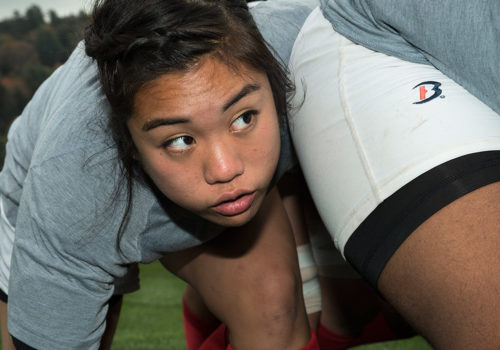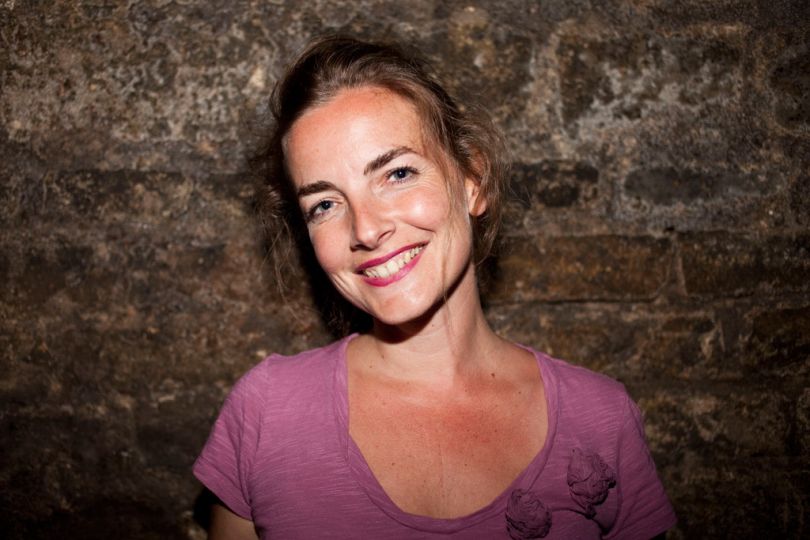Here is the interview with Alejandra Carles-Tolra and Sophie Bernard in the context of our coverage of the festival Circulation(s). « The Bears » is presented in the Jury Selection’s , the series portrays the women’s rugby team of Brown University .
Why did you become a photographer ?
I have always been fascinated with understanding how identities are created and shaped by our surroundings. While studying sociology I felt the need to use a more universal language that would allow me to broaden my audience. Photography became the perfect medium for me to continue exploring and expressing my interests. Questions regarding what defines our identities, the role surroundings and groups we’re part of play, and the threshold between individual and group identity drive and inform my work as an artist.
How did you find Circulation (s)? Why did you choose to be candidate ?
Through other photographers who had either attended or been selected on previous years (i.e. photographer Ruben Plasencia). I had only heard great things about the festival and the exposure it gives to your work so I decided to apply.
What do you expect of this festival?
To meet a great community of people, get exposure for my work, reach wider audiences and hopefully get other opportunities for new work, exhibitions or publications.
Do you do photography for living? Can you live of your photography (what kind of photography ? is it enough? is it easy?)
I do, I work as a freelance photographer doing journalistic and commercial work. It’s definitely not enough nor is it easy and I need to complement it with other jobs. I also teach photography and work with nonprofit organizations running workshops.
Could you say a few word about the serie you’ll present à Circulation (s):
What is it about? Why did you decide to it? Can you describe how you study or prepare the subject before shooting?
While spending a couple of years photographing ROTC cadets for my series “Fall In”, I learned about the experiences of women who perform in a male-dominated field. I then became very interested in photographing other women who were also part of a group in a predominantly male field. I had recently moved from Boston to Providence, when I found out about Brown University’s Women’s Rugby Club. I was immediately interested in learning more so I began doing research about the team, their history, the group identity and the sport. Finally, I decided to get in touch with them and schedule a meeting with the coach, where I had the chance to introduce myself and my work, and explain my interest in photographing the athletes. Soon afterward, I began attending their weekly trainings and games, and photographing the girls on a regular basis.
When joining the rugby team, these students are introduced to a community that not only challenges them to push their limits as athletes, but strengthens them both physically and mentally. I was drawn to portraying the young women who join the team, not only as a sport, but as a way to be introduced to a community with a strong identity where they can find their own. Women who join the sport are commonly pictured to fit a masculine stereotype. Through my portraits, I aim to bring a broader understanding of their identities, and what it means to be a woman who plays a male-dominated sport such as rugby. Rugby has a complex identity that is often simplified, and hence the identity of those who play it, especially women. In my photographs, I’m interested in enhancing the dualities that define both the sport and the athletes: violence and grace, weakness and strength, masculine and feminine. I hope my photographs are seen as a celebration of their strength and identity, which I believe play an important role in challenging the meaning of masculine sports, and pushing the boundaries of female identity.
Who are your masters (photographers, artists…) and why?
I’ve always admired the work of Diane Arbus, her portraits are so poignant and moving. They really transcend time. I also enjoy the video work of Rineke Dijkstra – every piece is very moving and speaks about the search for identity in a very unique way. Felix Gonzalez-Torres, who knew how to touch upon social issues in the most poetic of ways. Writer Junot Diaz is also a big influence, he is brilliant at describing human and crosscultural relationships, and visually I love Wes Anderson’s sense of composition and style.
Do you think that a picture (or photography) can change the world?
Absolutely! I think a photograph can raise enough questions to start changing the world.
Does photography change the way you see the world ?
Definitely, photography helps me see life as intriguing as a mystery, as playful as a game, as engaging as a movie, as telling as a book, and as surprising as a gift. Photography keeps me alert, looking for things in new ways and brings new perspectives to life.
FESTIVAL
Festival Circulation(s) – Jeune Photographie Européeene
From March 26th to June 26th, 2016
CENTQUATRE
5 rue Curial
75019 Paris
France
Closed on Monday
http://www.festival-circulations.com
http://www.alejandractr.com

















